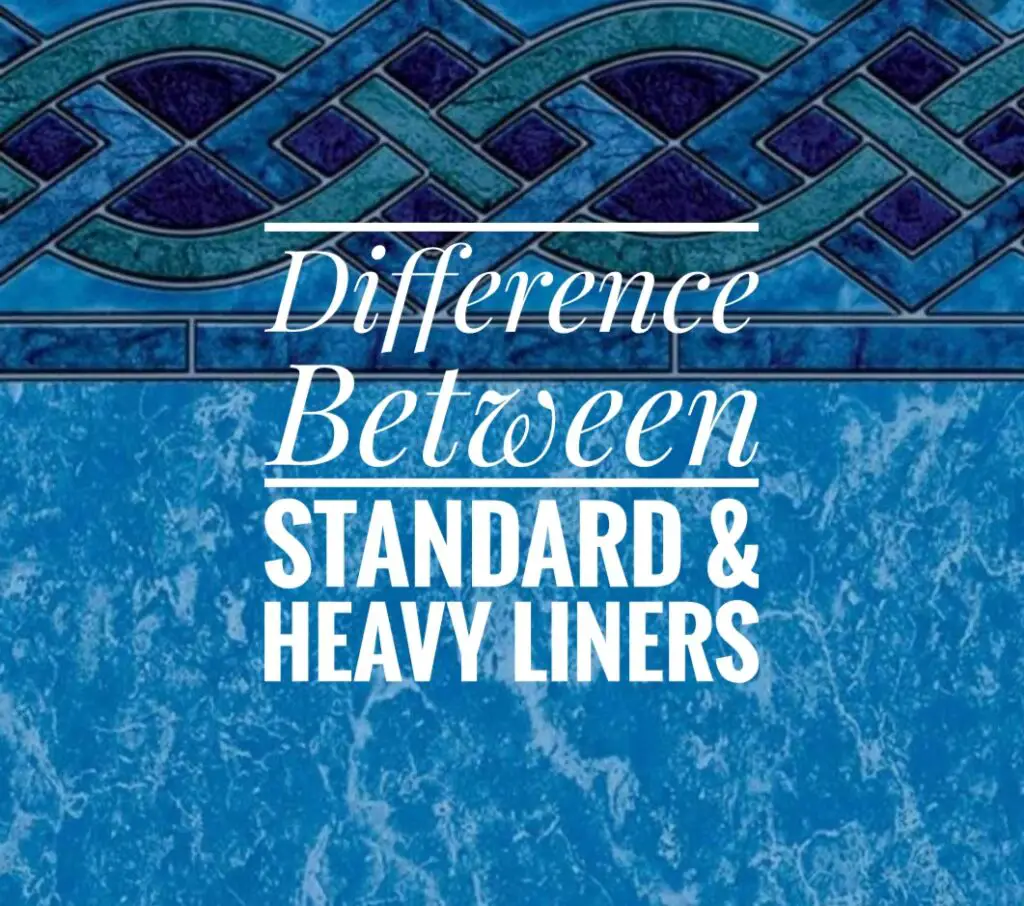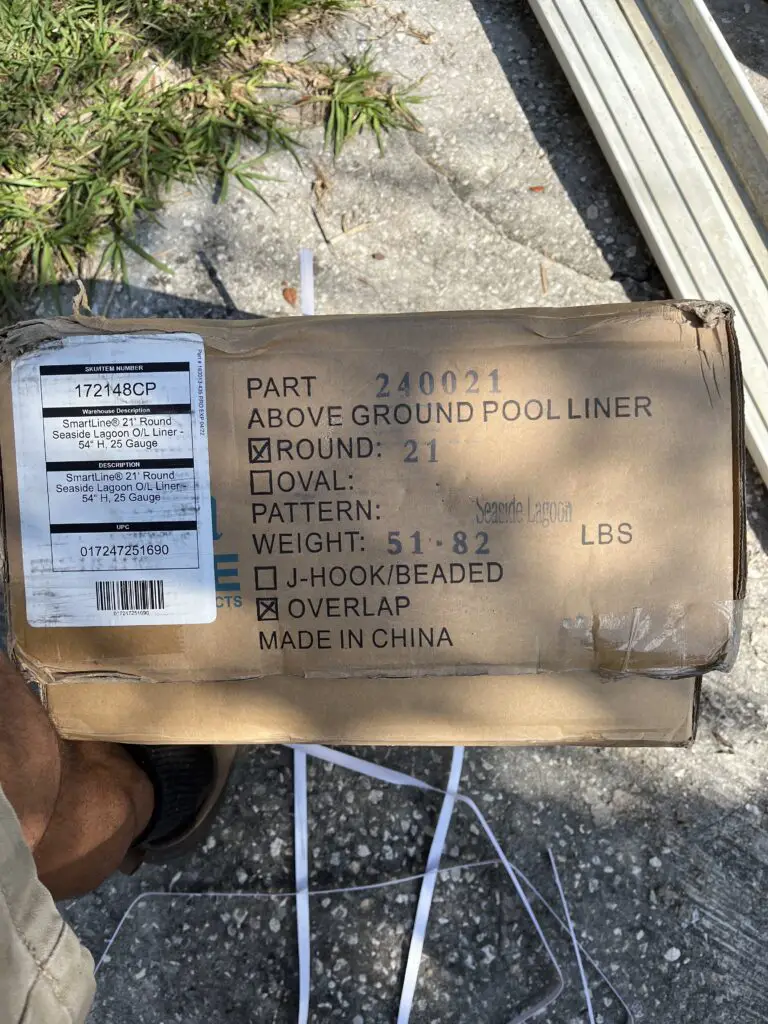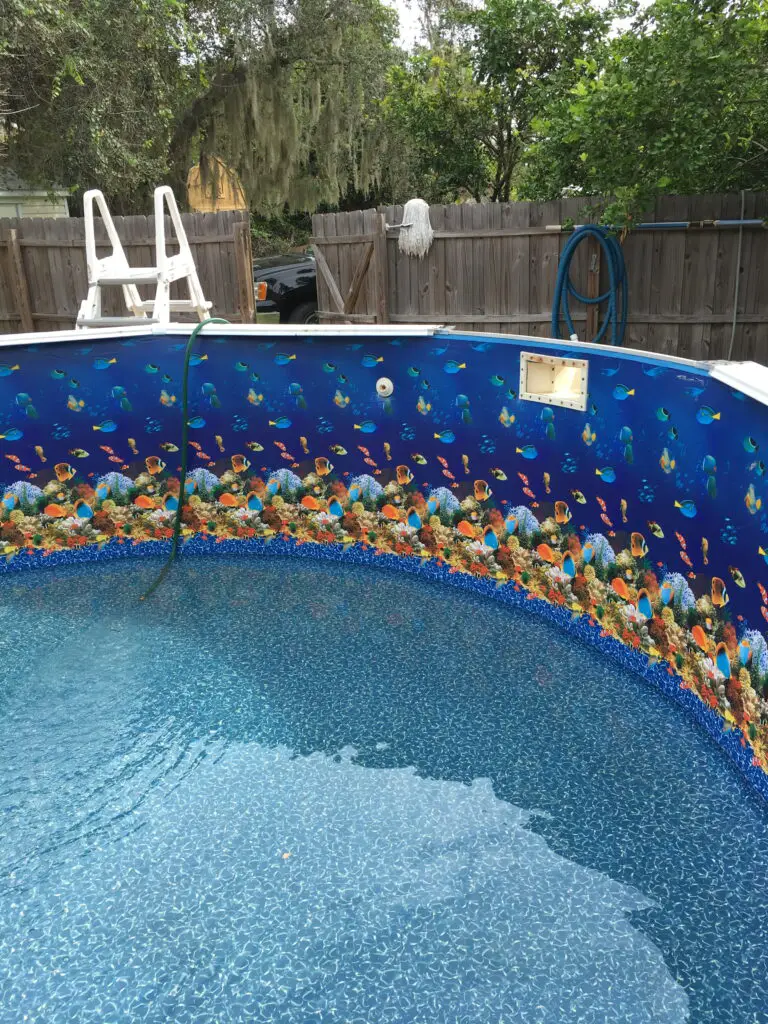Each year when people are looking to get an above-ground swimming pool, the ones that find me first always ask my advice on what to get. The number one thing I tell them to get is a heavy gauge liner for the pool.

But what is a heavy gauge liner for an above-ground pool? And how is it different from a standard liner? In this article, I will explain.
The only real difference between a standard gauge above ground pool liner and a heavy gauge one is how much it weighs. The names and descriptions (like 20mil, 20 ga, 25mil, 25 ga) are only marketing descriptions and not any real measurement of thickness.
“MIL” VERSUS “GAUGE” WHAT’S THE REAL DIFFERENCE
If you are looking for the short answer to this, then here you go “There is no difference between mil and gauge”.
These are two terms common in the description of above-ground pool liners, and they make no sense because they have no meaning.
Both “mil” and “gauge” are units of thickness used for other things, but not for above-ground pool liners. The liner industry and retailers just use these terms to describe the product.
If you are older like me, you might remember the actor Ricardo Montalban (best known in Fantasy Island) in those famous Chrysler Cordoba commercials. With his beautiful Latin accent, he would describe the car as having “rich Corinthian leather” seats.
Now, a car having leather seats is nice. But to have “Corinthian” leather would be the bomb except for one thing – there is no such thing as corinthian leather. It was just plain ol’ leather. Richardo sure sold a lot of those junky Cordobas though with just that one adjective that meant nothing.
Just like using the word “corinthian” to describe car seat leather, using “mil” or “gauge” with pool liners is the same. They are all meaningless.
WHERE “MIL” IS REALLY USED
The measurement called “mil” is really 1/1000th of an inch. This unit is used mostly in machinist manufacturing and is not the same as millimeter or mm for short.
“Mils” are also used to determine the thickness of plastic sheeting like Visqueen or trash bags. The higher the mils, the thicker the plastic product.
Out of the two, “mil” is closer to a real description of thickness for an above-ground pool liner than “gauge”.
WHERE IS “GAUGE” OR “GA” REALLY USED
Gauge is a unit of thickness(or weight) used primarily in the metal manufacturing industry. You can Google geek out on the origin of the term “gauge” in the early part of the industrial revolution here
Most guys over the age of at least 40 will know that when buying electrical wire, that its thickness is described in “gauge” or “ga” for short. We also know that it’s strange and senseless in that the higher the gauge number, the thinner the wire.
As an example, an extension cord with #12ga wire is thicker(and more expensive) than an extension cord made of #16 wire.
This helps prove the meaninglessness of using “gauge” in describing the thickness of a pool liner because a 25ga liner is thicker than a 20ga liner is. This is the opposite of how “ga” or “gauge” is used.
OK. SO IF GAUGE AND MIL MEAN NOTHING, WHAT DOES THE NUMBERS 20, 25, 30, 35 MEAN?

Most above-ground pool liners will have a number associated with their description. The two most common numbers you will see are “20” and “25”.
The numbers 30, 35, and even 40 are uncommon, but they are out there.
So if the terms “gauge”, “ga”, and “mil” don’t mean anything, then what is the difference between a 20ga and a 25ga liner? Or how about a 20mil vs 25mil? How about if one liner is a 25mil and another is a 25ga?
The best way that I can answer this is that the higher the number means the heavier or thicker the liner. This is almost 100 percent true when comparing a 20 vs a 25 liner. The 20 usually represents a standard gauge liner and the 25 represents a heavy gauge liner.
NOTE: Although equally meaningless, I prefer to use the term “gauge” when describing a liner as being heavy or standard. This is because saying “heavy mil” would make no sense at all while “heavy gauge” at least makes some sense.
To Help Make This Clear Then:
20mil or 20ga usually means it’s a standard liner
25mil or 25ga usually means it’s a heavy liner
30mil or 30ga usually means it’s a heavy liner (but not necessarily heavier than 25)
35mil or 35ga usually means it’s a heavy liner(but not necessarily heavier than 25)
40mil or 40ga usually means it’s a heavy liner (but not necessarily heavier than
25)
By looking at the above, you can see that the number “20” commonly represents a standard gauge (weight) liner and the numbers “25”, “30”, “35”, and “40” all can mean the same thing, which is a heavy gauge (weight) liner.
This can be confusing and misleading as some liners described as 25 thru 40 can all be the same thickness liner. It would make sense for you to think that if you bought a liner described with a higher number, that it would be heavier and thus a better liner. This is NOT always the case.
HOW I DISCOVERED THE TRUTH ABOUT ABOVE GROUND POOL LINERS DESCRIPTIONS

About ten years ago, I was involved in a website that sold above-ground swimming pools. The site was only a couple of years old then, and none of us involved knew much about having a website.
The question of the real difference between standard and heavy gauge liners kept coming up. And there was no definitive answer.
With having built a couple of thousand pools (at that time), I had real-world knowledge of the differences with liners but didn’t know why they were described as “mil” and “gauge” (ga) or why the numbers 16 thru 40 were used.
After hours of fruitless research, I decided to go to the source for the answer. Ten years ago (and probably still), the source was the liner manufacturer Swimline.
Swimline was by far the biggest maker of above-ground pool liners. Even now with much more competition, Swimline is still the biggest.
You might have thought it would be easy to get someone with a real answer to this question from Swimline. It wasn’t. Ten years ago, it was almost impossible to get anyone on the phone at Swimline. , let alone someone who had a real answer to my question of “What is the difference between your standard and heavy gauge liners?”
After several attempts and “hold-ons”, I finally got my answer from Swimline. With a sense of proprietary nature, they told me that the only difference between the standard gauge and heavy gauge liners (usually 20 for standard and 25 for heavy) was the actual weight of the liner and its warranty.
“So the numbers don’t represent any measurement?” I asked again.
“The only difference between the standard and heavy gauge liners are the weight and the warranty”, she only repeated.
That was all I could get from Swimline on the subject, but it was enough. We then weighed comparable liners and determined that heavy gauge liners weighed about eight percent more than the standard liners.
THE TWO AND ONLY DIFFERENCES BETWEEN STANDARD AND HEAVY GAUGE ABOVE GROUND POOL LINERS

Initially, we weighed only the Swimline liners to come up with the eight percent weight difference between standard and heavy. With being a pool website though, we shipped everything we sold, so we were then able to get the weights on all of the liners we offered.
The eight percent heavier ratio between a standard and heavy liner was pretty much the norm regardless of who made the liner. There are exceptions to this though. Some liners made by Latham are different and any liner that comes from China can be anything regardless of their description.
This eight percent weight difference equates to the heavy gauge liners being thicker. This has to be the case as the material and dimensions of the compared liners are exact. So the heavier weight means that they are thicker.
How much thicker in exact measurements is anyone’s guess. This is because the patterns on printed liners add their own amount of thickness depending on which pattern. For example, the popular fish liner (mostly called Caribbean) has a thicker print on it than most others. White swirl designs (Sunlight) will have less printing on them.
Besides the weight, the only other difference between a standard and heavy liner is the warranty. Typically a standard liner will have a 15 year pro-rated warranty with the first year covered 100%.
A heavy gauge liner will typically have a 25-year warranty with the first two years being 100% covered. None of these liners will last even close to 15 years, so any real difference between the two is with the 100% coverage length at the beginning.
Learn the truth about liner warranties here.
THE RATE OF FAILURE FROM MANUFACTURER’S DEFECTS ARE THE SAME WITH STANDARD AND HEAVY GAUGE
Just about the only thing that is truly covered with these liners under the warranty is if there is a seam separation. Seam separations are fairly rare, but they do happen. I average about one seam separation in every two hundred liners I install.
Seam separations suck, but getting a heavier liner will not decrease your odds of getting one. These are just defects that don’t care how much the liner weighs.
WHY YOU SHOULD ALWAYS GET A HEAVY GAUGE LINER
Even though there’s not as big a difference as you may think, a heavy gauge liner will last a few years longer than a standard one will. And since the price difference isn’t that much, it’s absolutely worth it.
Also, because the heavy gauge liner is a little thicker, it’s more durable. This means it can take a little bit more abuse like kids poking at it or dogs paddling against it.
Knowitall tip: I always recommend getting a fully printed liner. Solid blue liners (both standard and heavy gauge) don’t last nearly as long as a printed one.


So is there no point to getting a 30-40 gauge liner if it is not necessary heavier than 25? Is it basically the same thing?
It certainly can be. Sometimes the liners labeled 30 or 40 gauge are in fact heavier (thicker). These should be verified though through the manufacturer. Of course, the retailer will tell you its better as they charge more for them.
I have choice between 30 or 40 gauge liner, the cost difference is about $200. Which liner would you recommend?
The problem here is that I don’t trust that the 40 is a heavier liner than the 30. If you can somehow verify this and the liner is bigger than an 18′ round, then yes, I would spend the extra $200.
I have a pool company wanting to sell me a doughboy pool line for my 27’ 54” round pool 14 gauge . He tells me the smaller the gauge is a thicker pool liner. He did a comparison to buying wiring. The smaller gauge wire the more currant amp it carries. Am I getting ripped off? He says the cost for the liner is $900 and it comes with a 3 year warranty. .
I have never heard of a liner being sold as a 14 gauge. This is not to say that it’s wrong or bad. It’s just not the description usually used. I don’t know if you are getting ripped off as I don’t know which liner it is that is being sold to you.
I will suggest you find out where it’s made and what the 3 year warranty means? Most liners have much longer warranties, but the length of the warranty is meaningless as they are prorated and only good for manufacturer’s defects. So, this 3 year warranty may be a 3 year (full), which means if a manufacturer’s defect within 3 years, then 100% fully covered. Read here about liner warranties: https://abovegroundpoolsknowitall.com/the-truth-about-above-ground-pool-liner-warranties/
If the liner is made in the US or Canada and is fully printed, then $900 for a 27′ liner sounds within range.